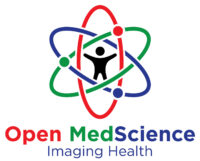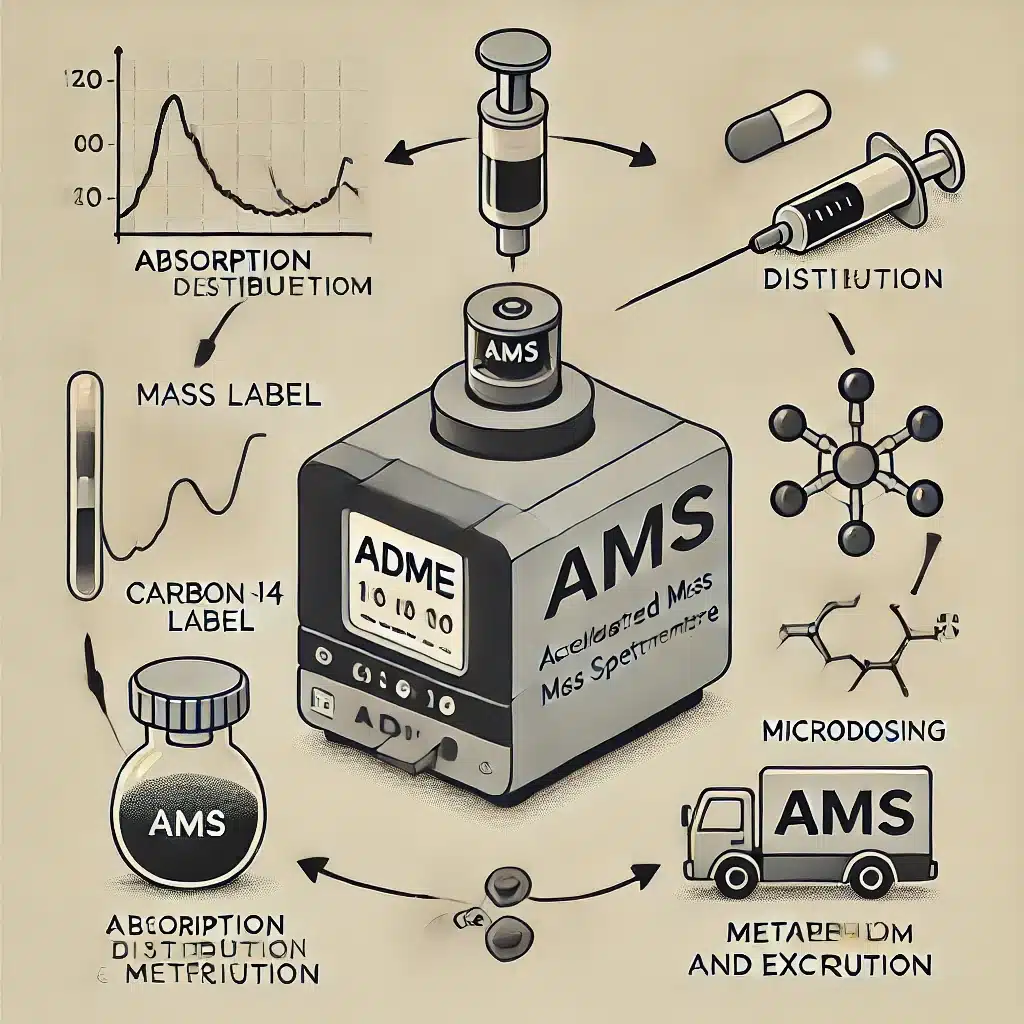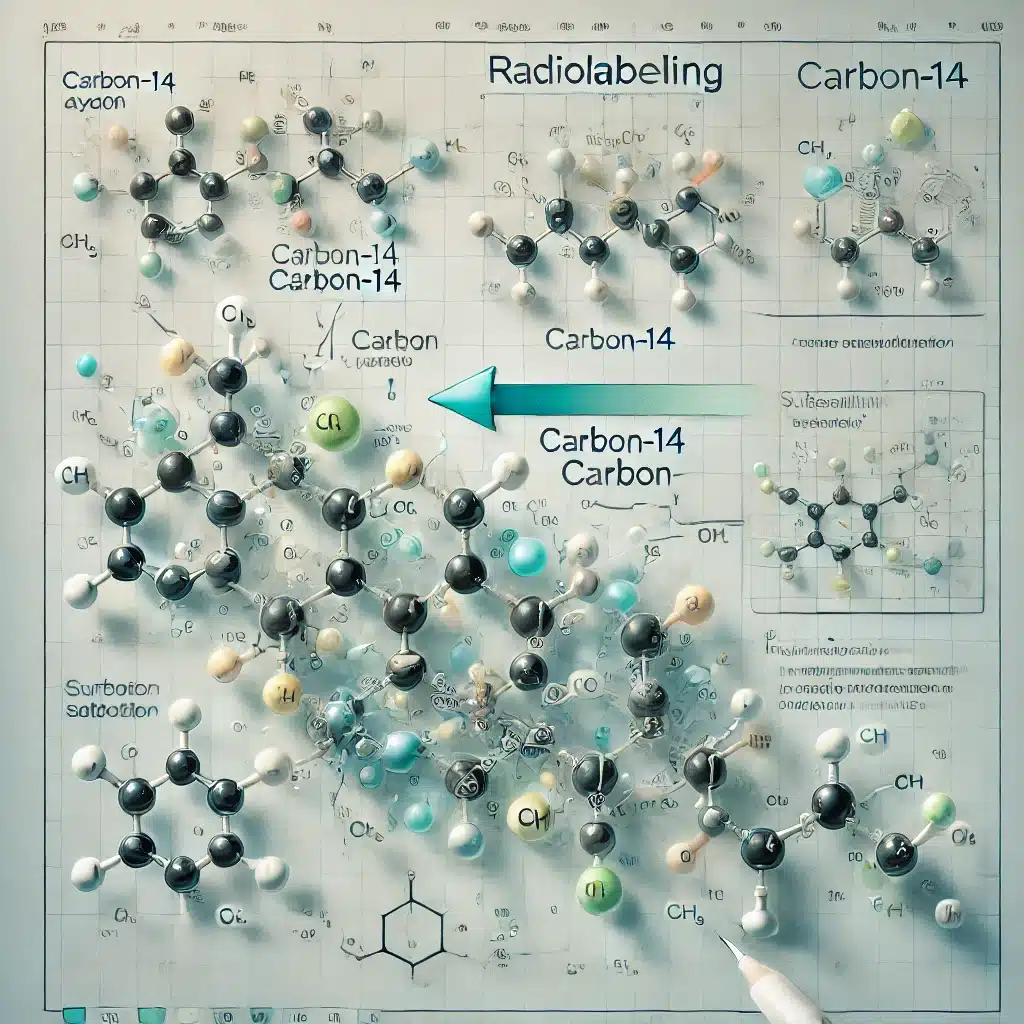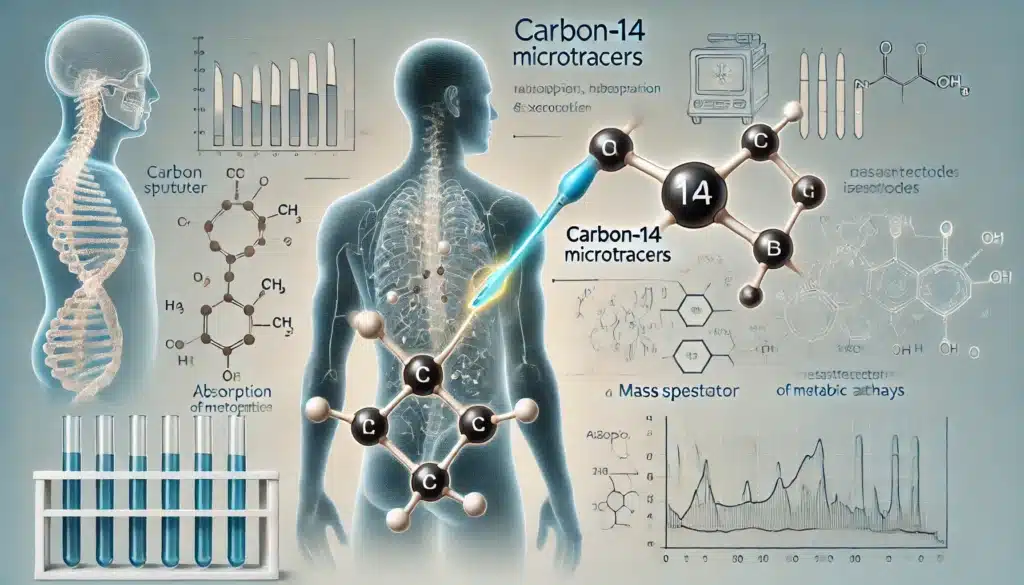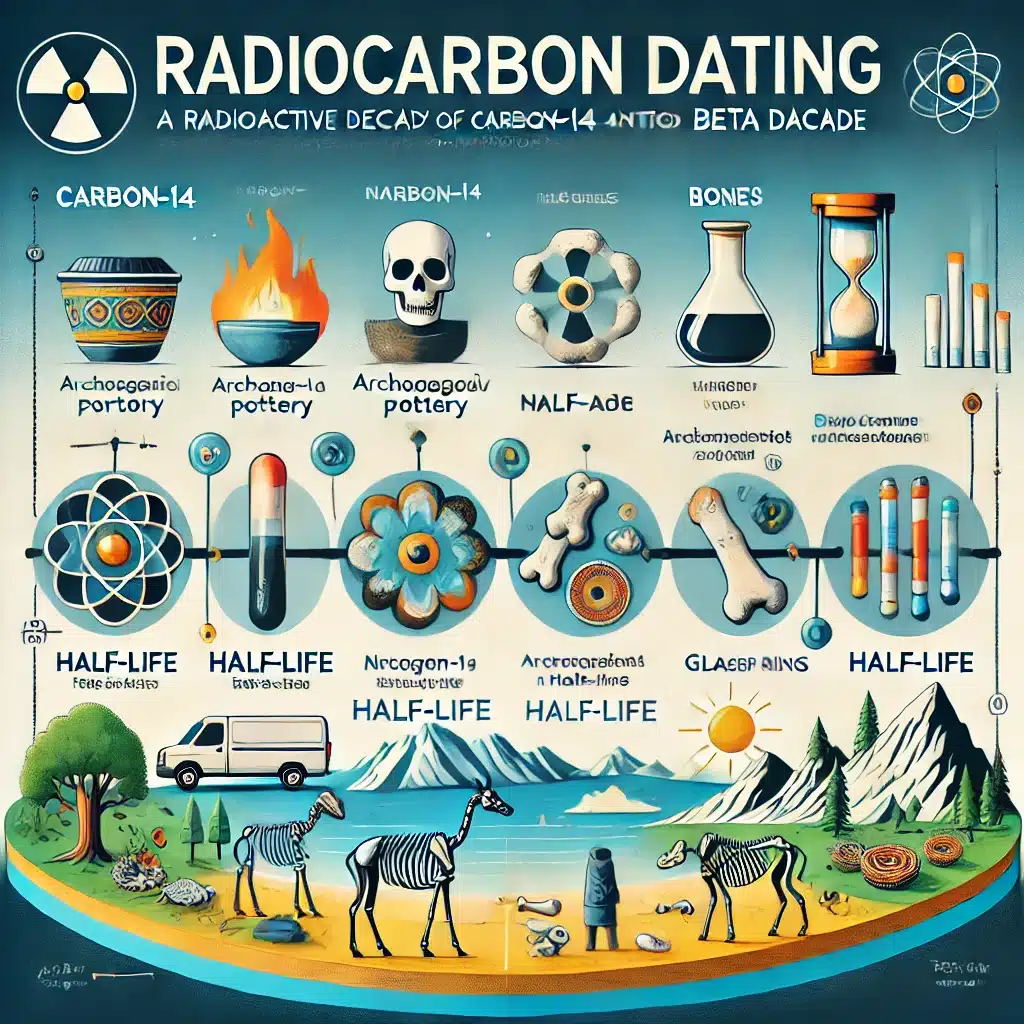Summary: Late-stage carbon-14 labelling and isotope exchange techniques have emerged as essential tools in the synthesis of radiolabelled compounds, particularly in the pharmaceutical and life sciences sectors. By allowing the direct introduction or replacement of carbon-14 into complex molecules at a late stage of synthesis, these methods streamline the production of radiotracers for metabolic and pharmacokinetic studies. This article examines the principles, recent advancements, and practical applications of these techniques, illuminating their transformative impact on radiochemistry and drug development.
Keywords: Carbon-14, isotope exchange, radiolabelling, late-stage functionalisation, radiotracer, pharmaceutical synthesis.
Introduction
Radiolabelling with carbon-14 has long been indispensable in pharmaceutical research, enabling detailed studies of absorption, distribution, metabolism, and excretion (ADME) of drug candidates. Traditionally, incorporating carbon-14 into molecules required lengthy synthetic routes, starting from simple radiolabelled building blocks. However, the advent of late-stage carbon-14 labelling and isotope exchange has significantly advanced the field by allowing the incorporation of carbon-14 into complex molecules at or near the end of a synthetic sequence.
These approaches not only reduce synthetic burden and radioactive waste but also provide enhanced access to labelled analogues of drug candidates with minimal structural alteration. The use of isotope exchange, in particular, offers a route to label compounds without the need for de novo synthesis. This article examines the methodologies, challenges, and applications of late-stage carbon-14 labelling and isotope exchange in modern radiochemistry.
The Importance of Carbon-14 in Research
Carbon-14 is a long-lived beta-emitting radionuclide with a half-life of approximately 5,730 years, making it ideal for tracing studies over extended periods. Its chemical behaviour is nearly identical to that of stable carbon, allowing it to be used in metabolic studies without altering the parent molecule’s behaviour.
In drug development, carbon-14-labelled compounds are employed in human and animal ADME studies, providing quantitative data on pharmacokinetics and bioavailability. Such studies are crucial for regulatory submissions and for understanding a drug’s complete metabolic fate. As regulatory agencies increasingly demand radiolabelled studies for new drug applications, efficient methods for incorporating carbon-14 have become a pressing necessity.
Limitations of Traditional Labelling Methods
Conventional carbon-14 labelling often involves the synthesis of a radiolabelled core or precursor, which is subsequently elaborated through a multi-step synthesis to yield the final compound. This approach, although reliable, is typically inefficient for complex drug molecules due to their lengthy synthetic routes and low overall yields. The use of radioactive materials throughout an extended synthesis also raises issues of safety, waste management, and cost.
Moreover, designing a synthesis route to accommodate a radiolabel can impose constraints on the overall strategy, particularly if the label must be introduced early in the process. It also limits the flexibility to explore multiple structural analogues in parallel. As a result, the field has shifted towards methods that allow late-stage introduction of carbon-14, primarily through isotope exchange, which offers a more streamlined and flexible approach.
Concept and Mechanism of Late-Stage Labelling
Late-stage labelling refers to the incorporation of a radiolabel into a molecule after the majority of the synthetic steps have been completed. This can be achieved via functional group interconversion, cross-coupling reactions, or isotope exchange. The key advantage is that the complex molecular architecture is built using non-radioactive intermediates, with radiochemistry only introduced at the final or penultimate stage.
One of the central challenges in this approach is the need for highly selective and efficient reactions that tolerate a broad range of functional groups. Ideally, these reactions should occur under mild conditions to prevent degradation of the compound and minimise radiolysis. Late-stage labelling therefore benefits from advances in modern organic synthesis, such as transition metal catalysis, photoredox chemistry, and organocatalysis.
Isotope Exchange: An Elegant Alternative
Isotope exchange is a particularly attractive method for introducing carbon-14 into molecules, as it involves the direct replacement of a stable carbon atom with a radioactive isotope without the need to resynthesise the molecule from scratch. This is especially powerful when the labelled position is not easily accessible through conventional synthetic routes.
In isotope exchange, labelling occurs at a position in the molecule that is chemically identical or similar to the stable carbon it replaces. Depending on the mechanism, this may involve reversible bond activation or exchange at specific functional groups, such as carboxylic acids, carbonyls, or aromatic rings. Catalysts, including metal complexes and enzymes, can facilitate this process by enabling bond cleavage and reformation under mild conditions.
For example, decarboxylative carboxylation reactions using labelled CO₂ have proven highly effective. Here, a pre-existing carboxyl group is exchanged with carbon-14 labelled carbon dioxide in the presence of a catalyst. This approach enables the labelling of drug molecules containing carboxylic acid groups, such as non-steroidal anti-inflammatory drugs (NSAIDs), with high regioselectivity and good radiochemical yields.
Recent Advances in Methodology
The last decade has seen substantial progress in the development of late-stage labelling protocols, particularly for isotope exchange using carbon-14. Notable contributions include palladium-catalysed carbon–carbon bond formation reactions using [¹⁴C]-labelled building blocks, and photocatalytic techniques for introducing labelled carbon dioxide.
One significant breakthrough is the use of dual-catalyst systems that activate specific C–H bonds for labelling. Such methods enable the introduction of carbon-14 at previously inert positions, thereby expanding the scope of targetable molecules. Additionally, developments in flow chemistry have enabled radiolabelling to be performed under continuous conditions, enhancing safety, reproducibility, and scalability.
An example of this is the use of iridium-catalysed C–H carboxylation reactions that incorporate [¹⁴C]-CO₂ into aromatic compounds. These reactions proceed with high selectivity, avoiding the need for pre-functionalisation of the aromatic ring, which would otherwise require multiple steps. Other promising technologies include photoredox-mediated labelling, where visible light activates the substrate for reaction with labelled CO₂ or other carbon-14 sources.
Applications in Drug Development
The application of late-stage carbon-14 labelling in drug development is already well established, with several pharmaceutical companies adopting these methods to expedite radiotracer synthesis. The ability to label final or near-final drug candidates without significant route redesign reduces development time and cost.
Moreover, the use of isotope exchange in metabolic studies enables researchers to label specific positions within a drug molecule, allowing them to track biotransformations and identify key metabolites. This has direct implications for toxicological evaluation and regulatory approval.
Late-stage labelling also supports the development of positron emission tomography (PET) tracers, particularly when labelling with short-lived isotopes such as carbon-11 is impractical. In such cases, carbon-14 labelling serves as a complementary tool for preclinical studies that require longer observation periods.
Regulatory and Practical Considerations
While the synthetic advantages of late-stage labelling are clear, several practical considerations must be addressed. Radiochemical purity, specific activity, and the stability of the labelled compound are all critical parameters that influence the quality of the final product. Additionally, the choice of labelling position should be guided by the drug’s metabolic profile and the intended application.
From a regulatory perspective, carbon-14-labelled studies are typically required by the EMA and FDA to support the pharmacokinetic characterisation of new chemical entities. The flexibility offered by late-stage methods helps companies meet these requirements more efficiently, reducing the environmental footprint associated with radioactive waste and improving laboratory safety by minimising the handling of radioactive materials.
Challenges and Future Outlook
Although late-stage labelling and isotope exchange offer considerable advantages, several challenges remain. Achieving uniform labelling at a single site, particularly in the presence of multiple reactive groups, can be difficult. There is also a continued need for new catalysts that operate under mild, aqueous, or biocompatible conditions to expand the utility of these methods to more sensitive compounds.
Another area of ongoing research is the development of universal labelling strategies that can be broadly applied across different molecular scaffolds. Advances in computational chemistry and machine learning may assist in predicting the reactivity and optimal conditions for isotope exchange, further accelerating the development process.
Looking forward, the integration of late-stage labelling with automation and miniaturised radiochemistry platforms could revolutionise radiotracer synthesis. These technologies could make radiolabelling more accessible to smaller research groups and broaden the scope of clinical and preclinical investigations.
Conclusion
Late-stage carbon-14 labelling and isotope exchange represent a shift in radiochemical synthesis towards more efficient, flexible, and sustainable methodologies. By enabling the direct incorporation of carbon-14 into complex molecules at the final stages of synthesis, these techniques reduce the need for elaborate radiochemical routes and facilitate rapid access to labelled compounds.
As the pharmaceutical industry continues to demand faster and safer ways to evaluate new drug candidates, the role of late-stage radiolabelling will only grow in significance. Continued innovation in this space promises to unlock new possibilities for radiotracer development, supporting more effective and informed drug discovery and development.
Disclaimer
The content of this article is intended for informational and educational purposes only. It does not constitute professional advice or recommendations for any specific application in radiochemistry, pharmaceutical development, or regulatory compliance. While every effort has been made to ensure the accuracy and reliability of the information presented, Open Medscience makes no warranties, express or implied, regarding the completeness, accuracy, or suitability of the content for any particular purpose.
Readers are advised to consult appropriate technical experts, regulatory authorities, or original research sources before implementing any processes or techniques described herein. The views expressed in this article are those of the authors and do not necessarily reflect the views of Open Medscience or its affiliates. The use of radioactive materials must comply with all applicable laws, safety regulations, and institutional guidelines.
Open Medscience accepts no liability for any loss, damage, or injury arising from the use or reliance on the information provided in this publication.
You are here: home » diagnostic medical imaging blog »